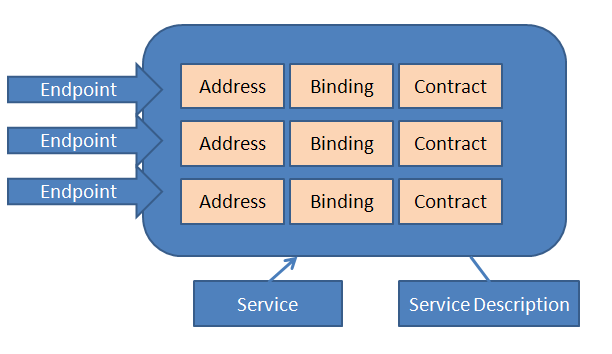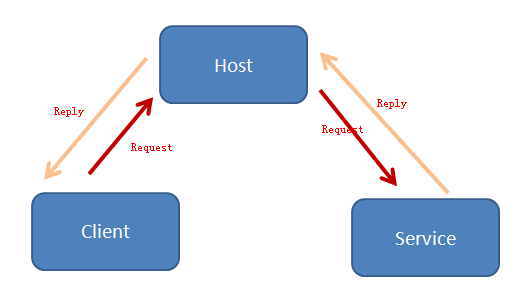|
WCF(三) Message pattern
上次咱们稍稍讨论了WCF中的contract,这次咱们讨论Message
Pattern.
WCF中为何会有message pattern呢?
我们知道WCF的Server端与client端是通过xml 来进行交互的.message pattern其实就是指server端与client端交互xml的方式.
wcf提供以下三种pattern:
1.Request-reply:client端调用server端的公开的method后,client端需等server端method返回结果(即:reply响应)以后,才能做继续client端的下一步操作.(如:client调用server端的method往数据库中插入一条数据.server端插入数据成功以后,返回相应的数据库插入成功信息.很多情况下使用的是这种.
2.one-way:client端调用server端的公开的method后,client端不需等server端的method返回结果,便可继续client端下一步操作.(如:server端记录client端的日志(log)信息).标识为One-way的operation(函数)的返回值只能是void.
当client向server 发起了request后,不需要server做出回应的情况使用one-way
message pattern.
3.duplicate:Request-Reply 和One-way都是先由client端发起的request(请求);duplicate则允许有server端发起request.
两种方式实现duplicate:一种是tcp(这里先不讲tcp的方式,先讲http的方式).一种是http.
Http方式的话:是先由client端发起一次one-way 的request,然后client不等待server端返回结果,而是端继续往下执行.当server端有结果返回时,再有server端发起一次one-way的request.所以duplicate也叫callback.
我们知道当一个操作很费时的话,为了减少UI的无响应,有更好的用户体验,会使用callback.wcf也是:当server的执行很耗时的话,我们可以使用duplicate的message
pattern.
4.实现:
4.1:Requst-Reply:是最简单的
[ServiceContract(CallbackContract = typeof(IDuplicateDemoCallback))]
2 public interface IService1
3 {
4 // 在函数中,我们让线程暂停,模拟耗时的操作.
5 // 参数:interval为暂停的毫秒数,由调用该method的client端设定.
6 [OperationContract]
7 void RequestReply(int interval);
8
9 [OperationContract]
10 void DuplicateCommunicate(int interval);
11
12 } |
4.2:One-Way:(只需要在requst-reply的基础上,使operationContract
的IsOneWay=true即可)
[ServiceContract(CallbackContract = typeof(IDuplicateDemoCallback))]
2 public interface IService1
3 {
4 // 在函数中,我们让线程暂停,模拟耗时的操作.
5 // 参数:interval为暂停的毫秒数,由调用该method的client端设定.
6 [OperationContract(IsOneWay = true)]
7 void RequestReply(int interval);
8
9 [OperationContract(IsOneWay = true)]
10 void DuplicateCommunicate(int interval);
11
12 } |
4.3Duplicate:(有些复杂)有以下步骤:
4.3.1:在server端IService.cs文件中添加代码:
// NOTE: You can use the "Rename" command on the "Refactor" menu to
change the interface name "IService1" in both code and config file together.
2 [ServiceContract(CallbackContract = typeof(IDuplicateDemoCallback))]
3 public interface IService1
4 {
5 // 在函数中,我们让线程暂停,模拟耗时的操作.
6 // 参数:interval为暂停的毫秒数,由调用该method的client端设定.
7 [OperationContract(IsOneWay=true)]
8 void RequestReply(int interval);
9
10 [OperationContract(IsOneWay=true)]
11 void DuplicateCommunicate(int interval);
12
13
14 }
15
16 public interface IDuplicateDemoCallback
17 {
18 [OperationContract(IsOneWay=true)]
19 void DuplicateCommunicateCallback(string callbackMessage);
20 } |
4.3.2:在web site项目下的web.config文件:使其支持wsDua
<?xml version="1.0"?>
2 <configuration>
3
4 <system.web>
5 <compilation debug="false" targetFramework="4.0" />
6 </system.web>
7 <system.serviceModel>
8 <behaviors>
9 <serviceBehaviors>
10 <behavior>
11 <!-- To avoid disclosing metadata information,
set the value below to false and remove the metadata endpoint above before deployment -->
12 <serviceMetadata httpGetEnabled="true"/>
13 <!-- To receive exception details in faults for debugging purposes,
set the value below to true. Set to false before deployment to avoid disclosing exception information -->
14 <serviceDebug includeExceptionDetailInFaults="false"/>
15 </behavior>
16 </serviceBehaviors>
17 </behaviors>
18 <serviceHostingEnvironment multipleSiteBindingsEnabled="true" />
19
20 <services>
21 <service name="WcfMessagePatternLib.Service1" behaviorConfiguration="">
22 <!-- Service Endpoints -->
23 <endpoint address="" binding="wsDualHttpBinding" contract="WcfMessagePatternLib.IService1">
24 <identity>
25 <dns value="localhost"/>
26 </identity>
27 </endpoint>
28 <endpoint address="mex" binding="mexHttpBinding" contract="IMetadataExchange"/>
29 </service>
30 </services>
31
32
33 </system.serviceModel>
34 <system.webServer>
35 <modules runAllManagedModulesForAllRequests="true"/>
36 </system.webServer>
37
38 </configuration> |
4.3.3在client端添加一个类文件命名为Callback.cs:
使其实现IDuplicateDemoCallback接口.
class Callback:ServiceReference1.IService1Callback
2 {
3 public void DuplicateCommunicateCallback(string callbackMessage)
4 {
5 MessageBox.Show(callbackMessage);
6 }
7 }
复制代码
1 private void Form1_Load(object sender, EventArgs e)
2 {
3 var context = new InstanceContext(new Callback());
4 proxy = new Service1Client(context);
5 } |
4.3.4修改client项目下的app.config文件:使其支持wsdualhttp
<?xml version="1.0" encoding="utf-8" ?>
2 <configuration>
3 <system.serviceModel>
4 <bindings>
5 <wsDualHttpBinding>
6 <binding name="WSDualHttpBinding_IService1" closeTimeout="00:01:00"
7 openTimeout="00:01:00" receiveTimeout="00:10:00" sendTimeout="00:01:00"
8 bypassProxyOnLocal="false" transactionFlow="false" hostNameComparisonMode="StrongWildcard"
9 maxBufferPoolSize="524288" maxReceivedMessageSize="65536"
10 messageEncoding="Text" textEncoding="utf-8" useDefaultWebProxy="true">
11 <readerQuotas maxDepth="32" maxStringContentLength="8192" maxArrayLength="16384"
12 maxBytesPerRead="4096" maxNameTableCharCount="16384" />
13 <reliableSession ordered="true" inactivityTimeout="00:10:00" />
14 <security mode="Message">
15 <message clientCredentialType="Windows" negotiateServiceCredential="true"
16 algorithmSuite="Default" />
17 </security>
18 </binding>
19 </wsDualHttpBinding>
20 </bindings>
21 <client>
22 <endpoint address="http://localhost:8167/WebHost/Service.svc"
23 binding="wsDualHttpBinding" bindingConfiguration="WSDualHttpBinding_IService1"
24 contract="ServiceReference1.IService1" name="WSDualHttpBinding_IService1">
25 <identity>
26 <dns value="localhost" />
27 </identity>
28 </endpoint>
29 </client>
30 </system.serviceModel>
31 </configuration> |
WCF(四) Configuration file (配置文件)
前面大致介绍了点wcf的几个小小的基本概念. 任何一个新技术,都能给我们带来一大堆的基本概念.
当然WCF也不例外. 关于WCF更多的概念,在以后再讨论.我们先讨论如何在不深入了解这一大堆学术定义的前提下,使用这项技术.
在开发过程中,使用configuration file (配置文件)具有很灵活的好处:以后有关于配置的改变,不必重新编译代码,只需打开configuration
file 改一下就行了,省时省力.
WCF中configuration file的地位不可忽视.当然我们可以使用code的方式,实现WCF的服务的每个阶段.
但我们的软件产品是需要给客户在实际工作中使用的. 我们要让软件产品的后期维护尽可能的简单,省时省力.
WCF的核心是Service. 一个service有包含多个endpoint,
如下图:

打开VS2010,File-->New project. 选择WCF Service Library
模板. Solution Name 和project Name我们都用默认的. 点击OK.
此时创建了一个WCF Library project. 打开App.config 文件,你会看到以下内容:
<?xml version="1.0" encoding="utf-8" ?>
2 <configuration>
3
4 <system.web>
5 <compilation debug="true" />
6 </system.web>
7 <system.serviceModel>
8 <services>
9 <service name="WcfServiceLibrary4.Service1">
10 <host>
11 <baseAddresses>
12 <add baseAddress = "http://localhost:8732/Design_Time_Addresses/WcfServiceLibrary4/Service1/" />
13 </baseAddresses>
14 </host>
15 <endpoint address ="" binding="wsHttpBinding" contract="WcfServiceLibrary4.IService1">
16 <identity>
17 <dns value="localhost"/>
18 </identity>
19 </endpoint>
20 <endpoint address="mex" binding="mexHttpBinding" contract="IMetadataExchange"/>
21 </service>
22 </services>
23 <behaviors>
24 <serviceBehaviors>
25 <behavior>
26 <serviceMetadata httpGetEnabled="True"/>
27 <serviceDebug includeExceptionDetailInFaults="False" />
28 </behavior>
29 </serviceBehaviors>
30 </behaviors>
31 </system.serviceModel>
32
33 </configuration> |
注:
第1行,定义该xml file的版本和使用的字符集. 是关于该配置文件的基本信息,与程序配置无关,只管保持默认即可.
第2行,<configuration> node,关于程序内的配置,都必须包含在此node里面.
第5行,是关于debug配置. 如果是在开发阶段,把它设为true,这样调试起来方便.
第7--31行,是<system.serviceModel> node, 关于wcf service的核心配置都在这个node里面.
该node下面有两个子node:一个是<services>,另一个是<behaviors>.
除此以外,还可以有<bindings>等.<services>是<service>的集合;<behaviors>是<behavior>的集合;<bindings>是<binding>的集合.
多说一句: WCF程序设计需要注意两方面的模型:一是编程模型;二是通信模型. 一般我们做web开发只需要编程模型,通信就交给http了.
但是wcf允许我们使用http以外的其他通信协议.所以,我们考虑了编程还必须考虑通信模型.好在wcf给我们提供了方便之处:它屏蔽了开发人员对通信模型的处理,只需要我们通过bindings
API创建通信模型即可. 所以,我们对bindings的指定,就是在处理通信模型.
第8--22行,是<services>node,该node下面有多个<service>node.
第9--21行,是<service>node,它的name指定了实现这个service的类名(全名,包括namespace).该<services>下面有一个<host>node,和多个<endpoint>node.(如上面我们提到的那张图)
.
第10行,是<host>node, <host>下面有<baseAddress>.
第11-13行,<baseAddress> node, <add>增加一个该service的基址,<endpoint>里面的address就相对于这个baseAddress的.
如果有多个baseAddress的话是根据<endpoint>所指定的binding方式与baseAddress的形式匹配的.(如,<endpoint>所指定的binding方式是netTcpBinding,就会匹配以net.tcp://打头的baseAddress.)
第15行,<endpoint>node,<endpoint>除了name以外,还有最重要的三部分组成,简称:ABC.
A是Address,B是Binding,C是Contract. Address可以是一个完整的URL,或是一个相对于基址的URL,如果为空,则使用基址.Binding指定通信模型比如:http,tcp,mssq等.
Contract就是服务的contract(就是前面我们使用[OperationContract]修饰的那个服务接口).
第20行,是元数据的<endpoint>,用与发布一些元数据信息.
先到这吧.....
WCF(五) Host WCF Service
这次我们讨论Host a WCF service.
前述
为了让client可以使用service,我们必须host service到一个每时每刻都在运行的环境中(我们叫Host
Application),因为它时刻等待着来自client的request(请求). Host有人翻译成"寄宿",我仍使用Host.
Host application负责start和endservice, 然后监听来自client的request,解析client的request,然后调用相应的service.
最后把结果返回给client.

Host Application为每一个Service 创建一个ServiceHost对象. 当有多个Service是,就会创建多个ServiceHost对象.
当client需要使用多种protocol(通信协议),如Http和tcp,此时你不必创建多个service,
因为前面我们知道一个Service可以有多个endpoint(endpoint 包含Address,Binding,Contract).
Binding指定不同的protocol,所以,我们只需创建多个endpoint,在binding中指定不同的protocol即可.
可以把service host到以下环境中:
1.IIS:我们需要创建一个Web Site,使用该Website去host wcf,然后将该website放到IIS中.
如果你使用了IIS去host wcf,那么只能使用http protocol. 当有request到来时,host
application可以自动激活,并开始监听.
2.WAS:(Windows Process Activation Service)作为IIS7.0的一个新特性.我们同样需要创建一个web
site .Vista,Windows 7, Windows Server2008 等操作系统可以安装WAS.
如果你使用了WAS去host wcf,可以使用http ,tcp,MSMQ,Named Pipe protocol.
当有request到来时,host application可以自动激活,并开始监听.
3.Managed Application(托管程序,如Console,WinFrom,WPF): Self-Hosting.
当有request到来时,host application不能自动激活.需要在代码中手动new出serviceHost对象.
我们如何选择哪一种host方式呢?
答案是:取决于你的操作系统,和通信需求,和特定场景.
1.如果你的操作系统是windows server2003,并且程序只用http即可满足需求. 那么使用IIS去host.
如果程序除了使用http不可满足需求(除了http,还需要tcp),则要创建window 服务去host.
2.如果你的操作系统是windows server2008(或 windows 7 )使用WAS. 因为它可以支持更多的protocol.
3.如果仅仅用于演示,可以使用Console去host. 但是release到真正的产品时,最好用winForm或WPF.
对于每一种方式,我们如何实现呢?
|